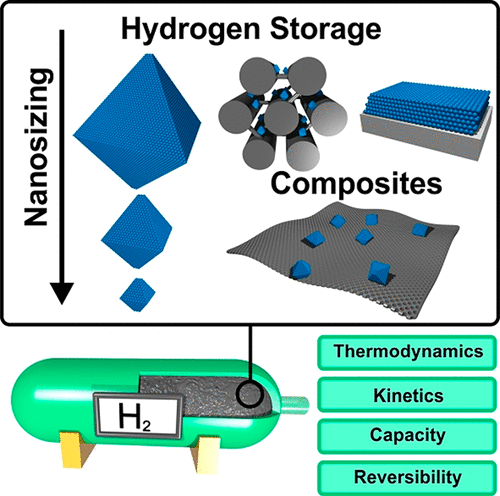当前位置:
X-MOL 学术
›
Chem. Rev.
›
论文详情
Our official English website, www.x-mol.net, welcomes your
feedback! (Note: you will need to create a separate account there.)
Nanostructured Metal Hydrides for Hydrogen Storage
Chemical Reviews ( IF 51.4 ) Pub Date : 2018-10-02 00:00:00 , DOI: 10.1021/acs.chemrev.8b00313 Andreas Schneemann 1 , James L. White 1 , ShinYoung Kang 2 , Sohee Jeong 3 , Liwen F. Wan 2 , Eun Seon Cho 3, 4 , Tae Wook Heo 2 , David Prendergast 3 , Jeffrey J. Urban 3 , Brandon C. Wood 2 , Mark D. Allendorf 1 , Vitalie Stavila 1
Chemical Reviews ( IF 51.4 ) Pub Date : 2018-10-02 00:00:00 , DOI: 10.1021/acs.chemrev.8b00313 Andreas Schneemann 1 , James L. White 1 , ShinYoung Kang 2 , Sohee Jeong 3 , Liwen F. Wan 2 , Eun Seon Cho 3, 4 , Tae Wook Heo 2 , David Prendergast 3 , Jeffrey J. Urban 3 , Brandon C. Wood 2 , Mark D. Allendorf 1 , Vitalie Stavila 1
Affiliation

|
Knowledge and foundational understanding of phenomena associated with the behavior of materials at the nanoscale is one of the key scientific challenges toward a sustainable energy future. Size reduction from bulk to the nanoscale leads to a variety of exciting and anomalous phenomena due to enhanced surface-to-volume ratio, reduced transport length, and tunable nanointerfaces. Nanostructured metal hydrides are an important class of materials with significant potential for energy storage applications. Hydrogen storage in nanoscale metal hydrides has been recognized as a potentially transformative technology, and the field is now growing steadily due to the ability to tune the material properties more independently and drastically compared to those of their bulk counterparts. The numerous advantages of nanostructured metal hydrides compared to bulk include improved reversibility, altered heats of hydrogen absorption/desorption, nanointerfacial reaction pathways with faster rates, and new surface states capable of activating chemical bonds. This review aims to summarize the progress to date in the area of nanostructured metal hydrides and intends to understand and explain the underpinnings of the innovative concepts and strategies developed over the past decade to tune the thermodynamics and kinetics of hydrogen storage reactions. These recent achievements have the potential to propel further the prospects of tuning the hydride properties at nanoscale, with several promising directions and strategies that could lead to the next generation of solid-state materials for hydrogen storage applications.
中文翻译:

用于储氢的纳米结构金属氢化物
对与纳米级材料行为相关的现象的知识和基础理解是实现可持续能源未来的关键科学挑战之一。从体积到纳米尺寸的减小由于增强的表面体积比,减小的传输长度和可调谐的纳米界面而导致各种令人兴奋和反常的现象。纳米结构的金属氢化物是一类重要的材料,对于储能应用具有巨大的潜力。纳米级金属氢化物中的氢存储已被认为是一种潜在的转化技术,并且由于其与大批量金属氢化物相比具有更独立,更彻底地调节材料性能的能力,因此该领域正在稳步发展。与本体相比,纳米结构金属氢化物的众多优势包括可逆性提高,氢吸收/解吸热变化,具有更快速率的纳米界面反应路径以及能够激活化学键的新表面态。这篇综述旨在总结迄今为止在纳米结构金属氢化物领域中的进展,并试图理解和解释过去十年来为调整储氢反应的热力学和动力学而开发的创新概念和策略的基础。这些最新成就具有推动纳米级氢化物性能调谐的潜力,并提出了一些有前途的方向和策略,这些方向和策略可能会导致下一代用于储氢应用的固态材料。
更新日期:2018-10-02
中文翻译:

用于储氢的纳米结构金属氢化物
对与纳米级材料行为相关的现象的知识和基础理解是实现可持续能源未来的关键科学挑战之一。从体积到纳米尺寸的减小由于增强的表面体积比,减小的传输长度和可调谐的纳米界面而导致各种令人兴奋和反常的现象。纳米结构的金属氢化物是一类重要的材料,对于储能应用具有巨大的潜力。纳米级金属氢化物中的氢存储已被认为是一种潜在的转化技术,并且由于其与大批量金属氢化物相比具有更独立,更彻底地调节材料性能的能力,因此该领域正在稳步发展。与本体相比,纳米结构金属氢化物的众多优势包括可逆性提高,氢吸收/解吸热变化,具有更快速率的纳米界面反应路径以及能够激活化学键的新表面态。这篇综述旨在总结迄今为止在纳米结构金属氢化物领域中的进展,并试图理解和解释过去十年来为调整储氢反应的热力学和动力学而开发的创新概念和策略的基础。这些最新成就具有推动纳米级氢化物性能调谐的潜力,并提出了一些有前途的方向和策略,这些方向和策略可能会导致下一代用于储氢应用的固态材料。











































 京公网安备 11010802027423号
京公网安备 11010802027423号